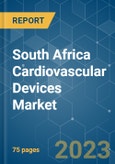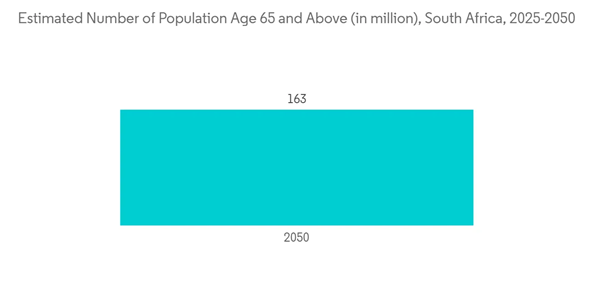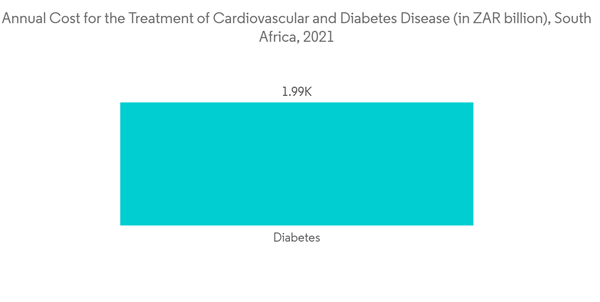The South African cardiovascular device market is poised to grow at a CAGR of 6% during the forecast period.
The COVID-19 pandemic affected the manufacturing of cardiovascular devices. The decrease in cardiovascular disease diagnoses due to healthcare resources allocated to COVID-19 patients had a detrimental influence on the market. According to the study published in Global Heart in March 2021, about 19% of hospitalized cases had evidence of cardiac injury. SARS-COV was associated with cardiomyopathy. Other cardiovascular findings include hypotension, arrhythmias, and sudden death. Persistent tachycardia was the most typical arrhythmia found in 72% of cases that persisted for weeks in COVID-19 patients. Thus, the cardiac disease market was significantly impacted during the pandemic as the number of cardiac incidences increased with COVID-19. However, the market has recovered well since the limitations were relaxed. The market recovery over the previous two years has been led by the increasing prevalence of heart illnesses and new product introductions.
The market is driven by the rising burden of cardiovascular diseases, technological advancement in cardiovascular devices, and increased awareness about cardiac diseases and treatment. The increasing burden of various coronary heart disorders, including cardiomyopathy and stroke, which account for most deaths from cardiac causes, is also driving the market. Cardiovascular diseases, the leading causes of death in South Africa, are the most prevalent ailments identified among the population. According to a study published in the Cardiovascular Journal of Africa in May 2021, every hour, five people have suffered from a stroke, and ten people suffered a heart attack. Additionally, obesity is a risk factor for CVD, and the growing prevalence of obesity will propel market growth. According to the study published in BMJ Open Journal in February 2022, adults without private health insurance in South Africa have hypertension in about 8.22 million cases annually. According to estimates, hypertension contributes to 6,100 new cases of chronic renal and, 14,000 cases of ischemic heart disease annually, and 13,300 strokes. Thus, the growing prevalence of cardiovascular diseases will propel market growth.
Furthermore, various initiatives launched by the government and private organizations in the country are expected to boost the market. In March 2022, WHF (World Hewart Federation) organized a site visit to Maputo, Mozambique, as part of the Colours to Save Hearts program. The WHF initiative Colors to Save Hearts, which is run by the Mozambique Institute for Health Education and Research and implemented by the National Health Institute of Mozambique (INS), aims to educate parents, teachers, and kids about the connection between rheumatic heart disease (RHD) and sore throats. They also shared how to recognize the symptoms of RHD and what to do when they first appear.
Thus, all factors mentioned above, such rising prevalence of cardiac diseases and government initiatives, are expected to boost the market in the country over the forecast period. However, a stringent regulatory scenario is expected to restrain the market growth over the forecast period.
According to the article published by South African Health Review in October 2021, South Africa's population is estimated to be 57.3 million in 2021. 8.3% of whom are aged over 60 years, and the number of older adults in South Africa will increase to 15.4% of the total population by 2050. The geriatric population is more prone to cardiovascular diseases, and the growth of this population in the country is likely to support the segment's growth over the forecast period.
Moreover, the rising healthcare spending and the number of hospitals are more likely to support the target market's expansion in the country. For instance, in April 2022, the Netcare Property Holdings Joint Venture opened a 400-bed multi-specialty hospital in South Africa. Thus, such hospital expansion in South Africa will create opportunities for cardiovascular devices, fuelling market growth.
Thus, all the factors mentioned above, such as the growing geriatric population, are expected to boost segment growth over the forecast period.
According to the study published in the Journal of Cardiovascular Diseases and Development in August 2022, the implantation of an LVAD causes a rapid and considerable decrease in GDF-15 concentrations in individuals with advanced HF. As a result, assessing GDF-15 plasma concentrations after LVAD installation could aid in monitoring therapeutic response. Thus, the advantages of the assisting devices will boost the market over the forecast period.
The various strategies adopted by the key market players, such as product launches, mergers, and acquisitions, partnerships, are respected to boost the market over the forecast period. For instance, in June 2021, in South Africa, Netcare Hospitals performed the first procedure to insert a tiny device known as the Abbot HeartMate 3 LVAD left ventricular assist device. Doctors can use this device for advanced heart failure patients needing short or long-term mechanical circulatory support. Thus, increasing the adoption of CHF treatment devices in the country is further expected to boost the studied market's growth during the forecast period.
Moreover, increasing spending on cardiovascular diseases will further propel the market's growth over the forecast period. Thus, all factors mentioned above, such as the benefits of assisting devices in managing cardiac diseases and product launches by market players, are expected to boost the market over the forecast period.
This product will be delivered within 2 business days.
The COVID-19 pandemic affected the manufacturing of cardiovascular devices. The decrease in cardiovascular disease diagnoses due to healthcare resources allocated to COVID-19 patients had a detrimental influence on the market. According to the study published in Global Heart in March 2021, about 19% of hospitalized cases had evidence of cardiac injury. SARS-COV was associated with cardiomyopathy. Other cardiovascular findings include hypotension, arrhythmias, and sudden death. Persistent tachycardia was the most typical arrhythmia found in 72% of cases that persisted for weeks in COVID-19 patients. Thus, the cardiac disease market was significantly impacted during the pandemic as the number of cardiac incidences increased with COVID-19. However, the market has recovered well since the limitations were relaxed. The market recovery over the previous two years has been led by the increasing prevalence of heart illnesses and new product introductions.
The market is driven by the rising burden of cardiovascular diseases, technological advancement in cardiovascular devices, and increased awareness about cardiac diseases and treatment. The increasing burden of various coronary heart disorders, including cardiomyopathy and stroke, which account for most deaths from cardiac causes, is also driving the market. Cardiovascular diseases, the leading causes of death in South Africa, are the most prevalent ailments identified among the population. According to a study published in the Cardiovascular Journal of Africa in May 2021, every hour, five people have suffered from a stroke, and ten people suffered a heart attack. Additionally, obesity is a risk factor for CVD, and the growing prevalence of obesity will propel market growth. According to the study published in BMJ Open Journal in February 2022, adults without private health insurance in South Africa have hypertension in about 8.22 million cases annually. According to estimates, hypertension contributes to 6,100 new cases of chronic renal and, 14,000 cases of ischemic heart disease annually, and 13,300 strokes. Thus, the growing prevalence of cardiovascular diseases will propel market growth.
Furthermore, various initiatives launched by the government and private organizations in the country are expected to boost the market. In March 2022, WHF (World Hewart Federation) organized a site visit to Maputo, Mozambique, as part of the Colours to Save Hearts program. The WHF initiative Colors to Save Hearts, which is run by the Mozambique Institute for Health Education and Research and implemented by the National Health Institute of Mozambique (INS), aims to educate parents, teachers, and kids about the connection between rheumatic heart disease (RHD) and sore throats. They also shared how to recognize the symptoms of RHD and what to do when they first appear.
Thus, all factors mentioned above, such rising prevalence of cardiac diseases and government initiatives, are expected to boost the market in the country over the forecast period. However, a stringent regulatory scenario is expected to restrain the market growth over the forecast period.
South Africa Cardiovascular Devices Market Trends
Cardiac Rhythm Management Device Segment is Expected to Show Better Growth in the Forecast Years
Cardiac rhythm management is a part of electrophysiology used to manage heart functioning. The segment's high growth attributes to the rising burden of cardiovascular diseases, sedentary lifestyles, and an increasingly aging population. In recent years, heart rhythm problems (arrhythmias) have become prevalent and will rise further. Cardiovascular disorders, such as arrhythmias, stroke, and high blood pressure, are increasing the demand for cardiac rhythm management devices. Hence, these factors will positively impact the studied market in the forecast period.According to the article published by South African Health Review in October 2021, South Africa's population is estimated to be 57.3 million in 2021. 8.3% of whom are aged over 60 years, and the number of older adults in South Africa will increase to 15.4% of the total population by 2050. The geriatric population is more prone to cardiovascular diseases, and the growth of this population in the country is likely to support the segment's growth over the forecast period.
Moreover, the rising healthcare spending and the number of hospitals are more likely to support the target market's expansion in the country. For instance, in April 2022, the Netcare Property Holdings Joint Venture opened a 400-bed multi-specialty hospital in South Africa. Thus, such hospital expansion in South Africa will create opportunities for cardiovascular devices, fuelling market growth.
Thus, all the factors mentioned above, such as the growing geriatric population, are expected to boost segment growth over the forecast period.
Cardiac Assist Devices is Expected to Hold a Significant Market Share Over the Forecast Period
Cardiac assist devices are mechanical pumps to help persons with weak or failing hearts maintain cardiac function and blood flow. The device is implanted in the body and circulates blood from the heart's lower chambers to the rest of the body. Increasing sedentary lifestyle adoption and unhealthy food habits have led to increased cardiovascular disorders occurrence. Moreover, the increasing incidence of cardiovascular diseases will support the segment's growth over the forecast period. According to the study published in the Journal of Cardiovascular Diseases and Development in August 2022, the implantation of an LVAD causes a rapid and considerable decrease in GDF-15 concentrations in individuals with advanced HF. As a result, assessing GDF-15 plasma concentrations after LVAD installation could aid in monitoring therapeutic response. Thus, the advantages of the assisting devices will boost the market over the forecast period.
The various strategies adopted by the key market players, such as product launches, mergers, and acquisitions, partnerships, are respected to boost the market over the forecast period. For instance, in June 2021, in South Africa, Netcare Hospitals performed the first procedure to insert a tiny device known as the Abbot HeartMate 3 LVAD left ventricular assist device. Doctors can use this device for advanced heart failure patients needing short or long-term mechanical circulatory support. Thus, increasing the adoption of CHF treatment devices in the country is further expected to boost the studied market's growth during the forecast period.
Moreover, increasing spending on cardiovascular diseases will further propel the market's growth over the forecast period. Thus, all factors mentioned above, such as the benefits of assisting devices in managing cardiac diseases and product launches by market players, are expected to boost the market over the forecast period.
South Africa Cardiovascular Devices Market Competitor Analysis
The South African cardiovascular device market is moderately competitive and consists of several major players. The major players in the South African cardiovascular devices market are Abbott Laboratories, Boston Scientific Corporation, Canon Medical Systems Corporation, Cardinal Health, Inc., Edwards Lifesciences, GE Healthcare, Medtronic PLC, Siemens AG, and W. L. Gore & Associates.Additional benefits of purchasing the report:
- The market estimate (ME) sheet in Excel format
- 3 months of analyst support
This product will be delivered within 2 business days.
Table of Contents
1 INTRODUCTION
4 MARKET DYNAMICS
5 MARKET SEGMENTATION (Market Size by Value - USD Million)
6 COMPETITIVE LANDSCAPE
Companies Mentioned (Partial List)
A selection of companies mentioned in this report includes, but is not limited to:
- Abbott Laboratories
- Boston Scientific Corporation
- Canon Medical Systems Corporation
- Cardinal Health, Inc.
- Edwards Lifesciences
- GE Healthcare
- Medtronic PLC
- Siemens AG
- W. L. Gore & Associates
Methodology

LOADING...










